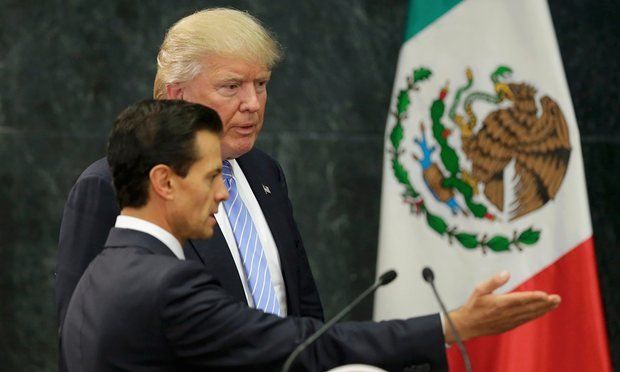
Enrique Peña Nieto meets with Donald Trump in Mexico´s Official Presidential Residence on August 31st, 2016
(Published in Dialogue, Kings College London Politics Society, No. 15: “The Politics of Hate”, pp. 30-31, October, 2016. Access to original)
Donald Trump´s visit to Mexico City with President Enrique Peña Nieto on August 31st, 2016, in the heat of the presidential election campaign, left many people speechless. How was it possible that the President of a Nation which has been systematically vilified and insulted by the Republican presidential candidate could have welcomed its attacker with open arms?
Even more surprising was the fact that Peña Nieto and Trump seemed to get along so well. During their joint press conference in Mexico City, Peña Nieto applauded their “fundamental agreements” on policy and offered to work with the Republican candidate to “strengthen” both the US-Mexico and the Mexico-Guatemala borders. During his turn at the microphone, Trump said Peña Nieto was his “friend”. Later, during his immigration speech in Arizona later that day, the Republican candidate called Peña Nieto a “wonderful president”, just as he simultaneously ratified his promise to build an "impenetrable, physical, tall, powerful, beautiful, southern border wall".
A few weeks earlier, the Prime Minister of Hungary, Viktor Urban, had publicly endorsed Trump´s candidacy. Peña Nieto did not go as far as Urban in his own public statements, but actions speak louder than words. By giving the Republican candidate the opportunity simultaneously to appear to be a statesman, as well as supposedly respectful of at least some Mexicans, Peña Nieto gave Trump just the helping hand he needed to bounce back in the polls.
Peña Nieto supposedly is not a nativist, neo-fascist like Trump or Urban. From the first day he took office in December of 2012, the Mexican President has been hailed by the international press as the example of a well-behaved neoliberal free-trader. Time magazine named him one of its "100 Most Influential People in the World," claiming that he "combines Reagan’s charisma with Obama’s intellect and Clinton’s political skills." The Financial Times raved that with the death of Venezuela’s Hugo Chávez, Peña Nieto may now take up the torch of Latin American leadership and revive the "Washington Consensus". Meanwhile, Thomas Friedman, of the New York Times, called Mexico the "Comeback Kid" under Peña Nieto.
How is it possible that a neo-fascist like Trump and a neoliberal like Peña Nieto get along so well? For instance, how can they possibly see eye-to-eye on key policy issues like the future of the North American Free Trade Agreement (NAFTA)?
The answer is both simple and profound. Right-wing “populist” nativism and neoliberal “free-market” authoritarianism are in fact two sides of the same coin. Trump and Peña Nieto are united by their common interest in empowering corporations over people and in their negative view of Mexican and Latin American workers and migrants. It is no coincidence, for instance, that the principal architect of the Trump-Peña Nieto encounter was the Mexican Finance Minister, Luis Videgaray, the closest man to Wall Street in the Peña Nieto cabinet.
This flies in the face of those who would suppose that the kindred spirits in Latin America for figures like Trump would be socialist nationalists like Hugo Chávez, Rafael Correa or Evo Morales. Those figures defend their people against the aggressions and impositions of neoliberal empire. In contrast, leaders like Peña Nieto are happy to work with whomever, Trump, Hillary Clinton or anyone else, to dismantle the remnants of Mexico´s national sovereignty and welfare state.
The Trump-Peña Nieto meeting is therefore only shocking if one assumes that neoliberals are democrats and that heads of state in the developing world necessarily defend their people. For those of us who have closely followed Peña Nieto´s presidency neither of these suppositions hold. His invitation to Trump was therefore not in fact a surprise. To the contrary, it was a logical continuation of the Mexican President´s own anti-Latin American fervor.
For instance, Peña Nieto already applies in Mexico the mass deportation policies that Trump has announced he would put into effect if he were elected President of the United States. Mexico today deports more Central American migrants than the United States and, with US funding and supervision, has made important new investments to “modernize” and “strengthen” its southern border. In other words, the Mexican government is doing the dirty work for the United States by stemming the flow of hundreds of thousands of migrants, many unaccompanied minors, from El Salvador, Honduras and Guatemala.
This is why President Barack Obama is just as happy with “his good friend and partner” Peña Nieto as Trump is. During the Mexican President´s most recent visit to Washington, on July 22nd, 2016, Obama criticized Trump´s proposal to build a wall on the Rio Grande by arguing that a loyal Mexican President is even more useful than brick and mortar: “If it were not for the hard work of Mexico in trying to secure its border to the south, and to cooperate with us, we would have a much more significant [illegal immigration] problem…The benefit of a cooperative Mexico… is going to do a lot more to solve any migration crisis or drug trafficking problem than a wall.”
Under Peña Nieto, Mexico has also privatized its oil and electricity industries, rolled back protections for labor, aggressively imposed neoliberal education reforms, increased covert surveillance of its citizens and consolidated the militarization of law enforcement. Freedom of expression and protest have also come under heavy fire under the present administration. Marches are systematically repressed, social and political leaders are jailed or assassinated, and journalists are censored, fired or murdered. All of these actions fit perfectly with Trump´s objective of “Making America Great Again” since they simultaneously subordinate the Mexican economy and its resources to the United States and increase the ability of the Mexican government to repress and control its people.
During the 2012 Mexican presidential election campaign, Peña Nieto´s daughter Paulina publicly defended her father by retweeting her boyfriend´s message calling critics “envious prole”, or resentful members of the working class. As the Federal Police descended on the people of the indigenous town of Nochixtlán, Oaxaca to forcefully break up their blockade of a highway, killing 9 and injuring over a hundred in the process, they shouted openly racist and classist epithets such as “‘‘¡Pinches oaxacos, ríndanse!’’ (“Just give up, Fucking Oaxacos!”), ‘‘¡Viejas chapulineras, váyanse a hacer tortillas!’’ (“Get back to your tortillas, old hags!”), ‘‘¡Putos huarachudos!’ (“Sandaled fags!”)’. Even Trump has been more careful with his words in public than Peña Nieto´s family and administration.
The Peña Nieto-Trump meeting is a wake-up call for those who think that the best way to combat the resurgence of the fascist right is by stubbornly holding onto the neoliberal center. Cold-war holdouts tend to argue that “populist” alternatives on both the right and the left are in the end the same since they both supposedly threaten democracy and the rule of law. But at least in the Mexican case, it is the “third way” which is in fact the closest ally to the return of fascism.
